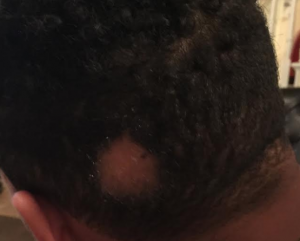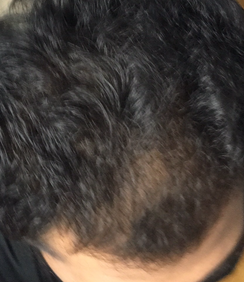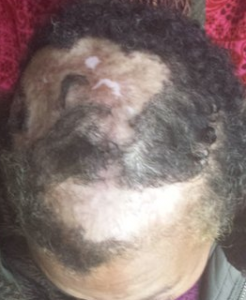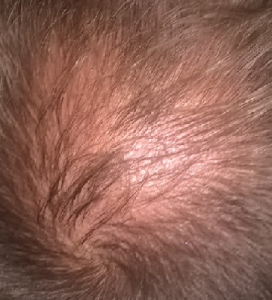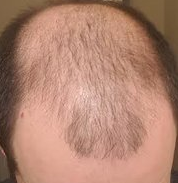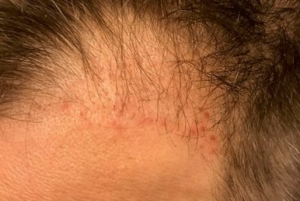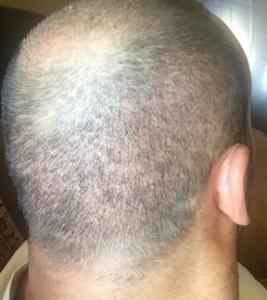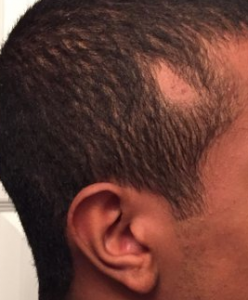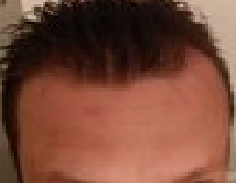At 18, if you have a hair transplant, you will almost certainly accelerate the loss that you see and get a much larger area. Then you will transplant it again, and more hair loss will follow with then a 3rd transplant and on and on. At your age, the best treatment is the drug finasteride which may very well reverse this without surgery and slow down the development of more hair loss. Doesn’t that make more sense?
This is a complex treatment that involves both balloon expanders and hair transplants. It will take some time to expand the existing scalp and you should look for a surgeon with considerable experience in this type of repair. Everything is not hopeless as I am optimistic that you can make the entire balding area normal again.
I am 21 years old, what does this mean for my future?
This is a sign that you will probably continue to bald in the crown. The drug finasteride, can be applied and maybe reverse this. Try it as you can buy it in the pharmacy, Keep on it for a year at a minimum to get any benefits. IF it does not solve your problem, see a doctor
This is a very important article for our readership, many who use hair dyes and some use hair relaxer agents. “I would be concerned about darker hair dye and hair straighteners,” epidemiologist Tamarra James–Todd said after reviewing the report online now in the journal Carcinogenesis. Tamarra James–Todd is professor, Harvard T.H. Chan School of Public Health, Boston, MA, but was not involved with the new research. “Black women who reported using dark hair dye had a 51% increased risk of breast cancer compared to black women who did not” making this statement very alarming considering the frequency of its use in the African American population”…. “Black women who used chemical straighteners and white women who used dark hair dyes were also at higher risk for breast cancer”…. “Previous studies have shown that long–term users of dark dyes have a 4–fold increased risk of fatal non–Hodgkin’s lymphoma and fatal multiple myeloma, the authors write. Prior research also has associated dark hair dye use with an increased risk of bladder cancer.
Clearly, there are two factors that are critical to determining the value of an FUE graft. (1) the thickness of the hair shaft itself is important as that reflects to weight of each hair shaft as it is viewed. A fine hair is less weight and less value than a coarse hair as shown in the patient’s magnified view of his donor area as he has coarse hair. I tell my patients that two fine hairs is equal to one medium weight hair and two medium weight hairs is equal to one coarse hair. (2) the numbers of hairs per graft is also critical. This is a racial thing, Caucasians average 2.2 hairs in each follicular unit, while all Asians average 1.6 hairs per follicular unit as do many people from the middle east. The patient’s donor area here measures about 1.6 hairs/follicular unit. He is of Arab decent so that makes him average. In this magnified photo, I tried to circle the number of hairs per follicular unit and put a number on many of them. This is what the surgeon sees when he is doing an FUE under magnification. An FUE removes the follicular unit and each FUE itself is created with a punch and has a wound associated with it.
If you ever read about the number of FUE grafts done in Turkey in the 5000 graft/session range, think about it and then look at the patient below. This patient has less hair density than a Caucasian and the number of grafts per FUE will have less hairs. That means that there will be more wounds created for the FUE with a less hair yield. In this man, if he had 5000 FUE grafts in the back of the head and did not develop necrosis of the wound, he would almost certainly develop a see through donor area (balding in the donor area) something that we are now fixing with Scalp Micropigmentation.
To determine if you are a good candidate for hair restoration, you need to know the following and put it all together (1) donor density, (2) degree of balding (you are advanced), (3) the thickness of your hair shafts (fine, medium or coarse, (4) the color of your hair compared to your skin (you have a high contrast between your brown hair and light skin which is not great) and (5) the degree of waviness of your hair (the more wavy, the better. If your donor density is low, the you might not have enough hair to cover the entire balding area and if you should continue to bald further, you may run out of donor hair before finishing. All of the hair in the center of your head is probably miniaturized and will sooner or later fall out. At 35, your hair loss should be slower. With all of this put together, your doctor can build a Master Plan for your hair restoration to account for not only the central hair that will almost certainly be lost, but the sides which may work their way down further than they are now.
I had a question regarding hair loss. In a perfect world, if hair loss did not exist, would males just have just a mature hair line which doesn’t indicate hair loss?
Yes, but 95% of Caucasian men develop a mature hairline, less among among Asians, Indians and Africans as each ethnic group may or may not develop a mature hairline. For those that do not, then they maintain their juvenile hairline like Bill Clinton did. He has had some erosion of his hairline but the line I drew is where his hairline was before he had his heart attack.
I had a hair transplant three weeks ago and these pimples bother me a great deal and they look horrible as well. What should I do?
This could be mild folliculitis. Go back to your doctor. He will probably want to lance one of these pimples and see if any pus comes out. In any event, a culture of the lanced pimple may yield a positive finding and if it does, then an appropriate antibiotic will be used to treat it.
You get screwed! This is why you do your research and you don’t go to the first local search on Google for a hair transplant… I dealt with a shady practice. A hair/wig stylist who ran the company based in CT, he basically had a cosmetic surgeon that they used the name of and to sign off on the surgery but not do any of the work. The nurses and the stylist did all of the incisions and the transplants. The guy who ran the company was a real sales man and I was naive at the time, made it seem like i didn’t need any drug and that the surgery would reset the clock 5 years and not need to be reassessed for at least another 5-10 more years.
The surgery itself… wasn’t great, wasn’t disfiguring though (as I learned later I got lucky) but long term there was no plan so i will be seeing another HT surgeon within the next few years if i have enough money saved up.
As Dr. Rassman said, the key is to develop a master plan and any good hair loss approach should start with stopping the hair loss and then addressing the transplant.
Right on. Well Said! The problem is far worse than you know. Doctors who know nothing about hair transplants, hire salesmen who sell the surgery and then they bring in teams of technicians who perform the surgery and even give the anesthetic. This is, of course, illegal but the prosecutors in each State don’t want to address this illegality because they say that they don’t have the budget. When some poor victim dies, then the prosecutors will go after the person who did it with Manslaughter charges if it is a non-doctor. If the surgery was done by an ignorant doctor who did not understand what he was doing, a death would just mean possibly loss of license (worst case) when it should be Manslaughter or murder. Our International Society for Hair Restoration Surgeons are very proactive, but the different governmental bodies just don’t seem interested. I for one, will volunteer my services as an expert witness in any prosecution in such circumstances as I have done before. Use this old axiom: LET THE BUYER BEWARE.
When I try to cut my hair in the back short, I see ‘holes’ from the FUE I had done a year ago.
There is a trade off between FUE and strip surgery. The large FUE sessions deplete the donor area and give you a see through look like what you have here while a strip procedure does not do this, but may give your a fine line scar on the back of the head. In either event, hair length may be important to cover the thinning of the back and side of your head, or if this is a problem, you can have Scalp Micropigmentation to make the back and sides of your head normal.
Shock loss is an acceleration of hair loss after the stress of a hair transplant. It is more common in younger men in their 20 and less common in men as they get older, like their 40s and 50s. The best prevention of it is the drug finasteride which seems to protect the patient against shock loss.
He could not make our new office opening even though he was invited so he wrote: “I’d be as bald as Mr. Clean had it not been for both of you guys…thanks again!“
I am 40 years-old and I have a high hairline with slight receded corners. Is it advisable to have a hair transplant to fix this? Are there any risks?
At 40 with only recession in the frontal hairline, you are a good candidate for a hair transplant that will move the hairline down. The greatest risk is acceleration of your hair loss. It is unusual to have significant hair loss if you only have recession at your age. To answer your second question, this risk is low.
Page 369 of 636

